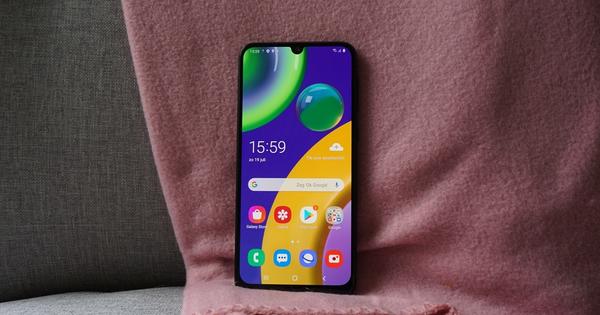An ordinary lamp or thermostat in the house is no longer of this time, nowadays all devices are smart. You control a security camera remotely with your smartphone and you regulate the temperature of your heating while you are still in the car. In this article you can read which equipment you can replace in a smart home with smart versions and what you should consider when purchasing.
 Eufy by Anker 5-in-1 security system: good and cheap November 17, 2020 17:11
Eufy by Anker 5-in-1 security system: good and cheap November 17, 2020 17:11  Google Nest Audio - Hear both sides November 11, 2020 16:11
Google Nest Audio - Hear both sides November 11, 2020 16:11  Ring Alarm: complete security system September 19, 2020 12:09
Ring Alarm: complete security system September 19, 2020 12:09
Step 01: A Smarter Home
Smart devices are all the rage, almost every television these days is smart and many home products have WiFi or Bluetooth on board to communicate with other devices. This phenomenon is also called the Internet of Things, known in English as the Internet of Things. This term encompasses the concept that all kinds of products - from tablets, smartphones and computers to thermostats, refrigerators and cameras - are connected to each other. In almost all cases this is wireless. Well-known concepts that you may encounter in this context are Home Automation, Smart Home or Domotica. All these terms mean the same thing: to make your home smarter. You can purchase a separate product from a different brand for each purpose, but there are also all-in-one solutions available. Sometimes you don't even have to go to the specialist store, some products are just for sale in the hardware store.
 You can buy a separate product for each purpose, but there are also all-in-one solutions available
You can buy a separate product for each purpose, but there are also all-in-one solutions available Step 02: Protocols
Each manufacturer chooses its own protocol with which the products work and this can make it difficult to mix products from different brands. Well-known protocols are Thread, Z-Wave, Zigbee, WiFi and Bluetooth. Thread is a protocol that Google uses for their Nest products, Zigbee is used by Philips, for example, for their Hue products. In most cases, you need a so-called hub for each protocol that you connect to your WiFi router. This hub then communicates with the relevant products.
The reason manufacturers opt for their own protocol instead of the widely available Wi-Fi is that Wi-Fi uses a lot of power and loses signal due to, for example, walls and other obstacles. Another disadvantage of Wi-Fi is that many devices already use your Wi-Fi network, which means that disruptions and failures can occur on the network. This is not so bad for an internet session on your PC, but a smoke detector must have a stable connection with other smart devices at all times. Apple has a new technology called HomeKit and this should ensure that different protocols can communicate with each other. HomeKit in itself is not a protocol, but if manufacturers add HomeKit to their products, a lighting system from manufacturer A can communicate more easily with a multimedia system from manufacturer B. Google also has a similar system, Google Weave.

Step 03: Thermostats
A well-known example of a smart device in the house is the thermostat. Every energy supplier has one these days. Toon from Eneco is a well-known example, but the Nest thermostat is also popular. A smart thermostat gives you insight into your energy consumption at any time of the day and this can save on your energy costs. In the case of a smart thermostat from your energy supplier, the company will take care of the installation, you have to do this at Nest itself.
All known thermostats can be controlled remotely with an app for Android or iOS. This way you can already switch on the heating at home from the train. In most cases, communication between an app and the thermostat is through a secure internet connection associated with an account. So you have to make sure you have a good password. In addition to smart thermostats, there are also smart smoke detectors on the market. You can buy one in the hardware store for a few tens, but if you want to buy a really smart product, you have to spend a little more. The Nest Protect costs around $100 but displays a narration explaining whether the smoke detected or the CO2 content of the air is an immediate threat to your health.

Step 04: Cameras
Another popular product is the smart camera, also known as IP camera. There are various applications for such a camera, for example you can use it as a modern baby monitor with image or as a security camera for indoor or outdoor use. Some cameras can also record sound or send a message to your smartphone when motion is detected. With a camera the quality is very important, the resolution is indicated in the number of pixels.
A camera of 640 by 480 pixels is good enough to check if your cats are behaving at home, but if you want to see sharp images of your garage, you will have to opt for an HD camera. Some cameras can be moved remotely via another computer or smartphone. The most important thing is that you come up with a strong password for an IP camera. By default, many devices have the access code 0000 or admin, this is of course asking for trouble. In principle, anyone can log in to your camera like this, there is even a website that directly publishes camera images from unsecured cameras. You can follow live what people are doing in an office or workshop or take a look inside the home of unsuspecting people. In addition, with most cameras you can see where the camera is located via a Google Maps map.
 There is even a website that directly publishes camera images from unsecured cameras
There is even a website that directly publishes camera images from unsecured cameras Step 05: Lamps
Switching on your lights with a simple push of a button has been possible for a while and the products are getting smarter and more energy efficient. Philips has the popular Hue series, a wireless lighting system that is controlled by the Hue bridge. This bridge is a box that you can control via the accompanying app for Android and iOS. The bridge then wirelessly sends signals to your Hue lamps, you can add up to fifty lamps to one bridge. In addition to normal light bulbs, Philips also offers LED light strips or the portable Hue Go lamp. There are of course more light systems on the market, Osram has the Lightify system, for example. The series is not yet as extensive as the Hue collection, but Osram also supplies a central control unit. This is called Gateway Home and you can plug it into your socket in no time. Just like with Philips, you then control the connected light sources via an app. Many systems also offer smart accessories, so you can add a sensor to your network and use the app to determine which lamps should control the sensor. If you walk in the hallway, for example, a light strip on the stairs comes on so that you can effortlessly walk upstairs.

 Eufy by Anker 5-in-1 security system: good and cheap November 17, 2020 17:11
Eufy by Anker 5-in-1 security system: good and cheap November 17, 2020 17:11  Google Nest Audio - Hear both sides November 11, 2020 16:11
Google Nest Audio - Hear both sides November 11, 2020 16:11  Ring Alarm: complete security system September 19, 2020 12:09
Ring Alarm: complete security system September 19, 2020 12:09 
